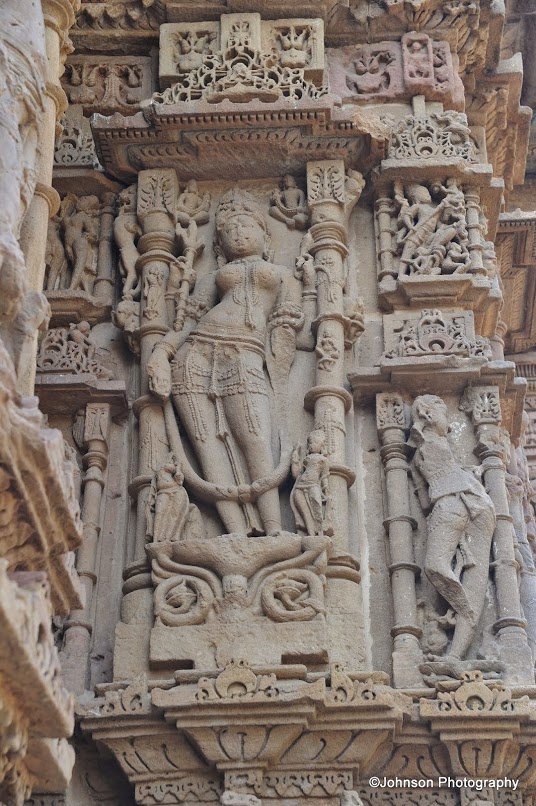The Sun Temple of Modhera was built during the reign of Bhima I of Solanki dynasty in 1026-27 AD. It resembles the better known Konark temple in Orissa, which it predates by 200 years. It was similarly designed so that the dawn sun shone on the image of Surya the sun god during the equinoxes.
Built in Solanki style the temple complex has three axially aligned components – the main shrine (garbhagriha) in a hall (gudhamandapa), the outer or assembly hall (sabhamandapa) and the sacred tank (kunda). The sabhamandapa is not in continuation with gudhamandapa but is placed little away as a separate structure. Both the structures are built on paved platform. Their roofs have collapsed a long ago. The platform of plinth is inverted lotus shaped.
The gudhamandapa measures 51×25 feet. It is almost equally divided into gudhamandapa, the hall and gabhagriha the shrine proper. The pradakshinamarga is formed by the passage between the walls of garbhagriha and the outer walls of gudhamandapa. The roof of the passage has stone slabs carved with rosettes.
Garbhagriha, the shrine proper, is square measuring 11 feet from inside. The outer walls of the shrine is highly decorated. The base and walls of the shrine and hall are divided into several stretches with unique carvings. The hall in front of the garbhagriha was roofed by a dome which is supported by eight principal pillars below arranged in an octagon, four pillars in front of shrine proper and two each in recesses of windows and door.
The sabhamandapa or the assembly hall has extensively carved exterior. There are 52 intricately carved pillars representing 52 weeks of the year. The roof was in shape of stepped pyramid, but no longer exists. Inside, the walnut shaped ceiling rises in tiers which has numerous floral girdles. It is 23 feet high and supported by pillars arranged in an octagon. Toranas or the decorated arches arise from the lower brackets of the pillars.
The tank in front of the temple is known as suryakunda. The flight of steps through kirti-torana leads to the reservoir. It is rectangular. It measures 176 feet from north to south and 120 feet from east to west. There are four terraces and recessed steps to descend to reach the bottom of the tank. Several miniature shrines and niches in front of the terrace wall have images of gods.




























The waning of the Solanki dynasty and the decline in Sun worship and the vagaries of the Islamic inconoclasts and devastating earthquakes led to the decline of the Modhera Sun temple. This masterpiece of Solanki architecture was plundered and defaced by the armies of Allauddin Khilji. The marauding soldiers placed gun powder inside the sanctum and set fire to it, creating an explosion that caused the main shikhara to collapse. In spite of all this and its magnificent dome missing, the Modhera Sun temple still remains as an architectural wonder, which can amaze any visitor.
The temple is located at Modhera village of Mehasana district in the Indian state of Gujarat.

Great photos. It looks amazing!
LikeLike
Thanks, Opher.
LikeLike
Wow. This is really impressive!
Is there a symbolism to the reliefs of the figures slanting their waist in one side?
LikeLike
It could be to show grace or divinity. This could be the intention, I believe.
LikeLiked by 1 person
Thanks for that snippet of info. Learn something new every day!
LikeLiked by 1 person
Wonderfull pictures I adore 🙂
LikeLike
Thank you very much for your comments.
LikeLiked by 1 person
The architecture and carving are remarkable. Thank you for sharing. Cheers
LikeLiked by 1 person
An amazing structure. And even more amazing to me is that it still exists after all this time!
LikeLiked by 1 person
Great photos! 🙂 ❤
LikeLike
Thanks.
LikeLiked by 1 person
😊
LikeLiked by 1 person
Beautiful. I love that natural hip-out stance in so many of the carvings. So sensual.
LikeLike
Thanks.
LikeLiked by 1 person
very beautiful
LikeLike
Thanks.
LikeLiked by 1 person
Wowwww thanks for sharing.stunning pix
LikeLike
Thank you very much for your visit and the comment.
LikeLiked by 1 person
☺☺
LikeLiked by 1 person